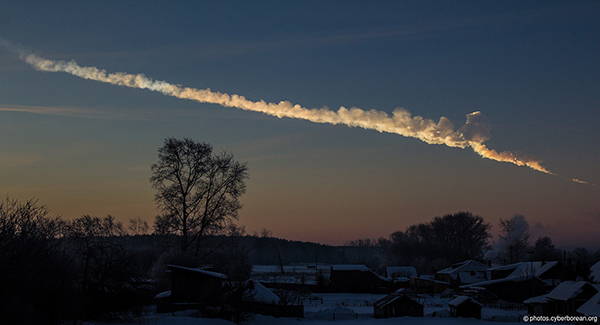
by Lisa A. Rossbacher Monday, April 15, 2013

A meteor estimated at about 20 meters in diameter streaked through the sky on Feb. 15, 2013, leaving an impressive trace over Chelyabinsk, Russia. ©Alex Alishevskikh, Creative Commons Attribution-ShareAlike 2.0 Generic

Lisa A. Rossbacher Courtesy of Lisa A. Rossbacher
Airplane pilots have a long history of using euphemisms to minimize the sense of risk in their work. Pilot-speak for crashing an airplane, for example, is “ruining your entire day.” In the same parlance, encountering an asteroid could cause all of us to have a very, very bad day. But maybe our close calls — such as the fireball that flew over Russia in February — can serve as reminders to renew our focus on searching for and understanding objects that could, literally, impact our planet.
On the morning of Feb. 15, 2013, a meteor brighter than the sun (which had barely risen on that late-winter morning) streaked across the sky above the Russian town of Chelyabinsk. The fireball was captured on video from countless angles, thanks to the prevalence of dashboard-mounted cameras in Russia. Some of the videos recorded the sonic boom created when the bolide flew overhead at about 23 kilometers above the planet’s surface. The fireball is estimated to have released an amount of energy equivalent to 440 kilotons of TNT — 30 to 40 times more than the atomic bomb dropped on Hiroshima. The sonic boom triggered car alarms and shattered windows. More than a thousand people sustained injuries, primarily cuts from falling glass and head trauma from a variety of other falling objects, but no one died.
NASA estimates the Chelyabinsk meteoroid was about 17 to 20 meters across, about the size of a railroad boxcar. The recovered meteorite fragments appear to be silicate-rich chondrites, which London’s Natural History Museum reports account for about 87 percent of all meteorites found.
Coincidentally, the Chelyabinsk fireball arrived on the same day that a known asteroid, 2012 DA14, was expected to pass within 30,000 kilometers of Earth’s surface, which happened without incident. 2012 DA14 has a composition similar to a carbonaceous chondrite, a much rarer type of meteorite. It is also far, far larger than the Chelyabinsk bolide was. 2012 DA14 was detectable because of its size and, perhaps more importantly, the direction from which it came. The meteoroid that created the Russian fireball was not observed in advance because it came toward the Earth from behind the sun, where no instrument could record it.
According to NASA, about 100 tons of extraplanetary material lands on Earth’s surface every day. (I have a colleague in California who is convinced that half of this total ends up in his swimming pool.) Some of this comes as dust from ice-rich comets that vaporize as they get close to the sun, but most of the material originated in long-ago collisions between rocky asteroids. The dust isn’t worrisome, unless you have to clear it all out of your pool filter. But the larger pieces are a different story.
NASA has a program, called WISE (Wide-field Infrared Survey Explorer), designed to track objects that have a reasonable chance of colliding with Earth over the next few hundred years and that are large enough to cause damage. The mission, launched in 2009, has provided the best summary to date of Potentially Hazardous Asteroids (PHAs) — bodies with orbits that bring them within 8 million kilometers of Earth’s orbit, that are large enough to survive passage through Earth’s atmosphere, and that would cause regional, if not planetary, damage on impact. A diameter of 100 meters is the size threshold for “potentially hazardous.”
Despite its relatively diminutive size, the recent Russian meteor event brings new relevance to the work of WISE. In May 2012, mission scientists estimated that about 4,700 (plus or minus 1,500) PHAs exist in our solar system, although only about 20 to 30 percent of these predicted objects have been found so far.
Here on Earth, according to WISE scientists, we can expect another 64 “very close approaches” of asteroids in the next two centuries. A relatively small asteroid, similar in size to the one that exploded over Russia, could come within 15,000 kilometers of Earth in October 2017. And on April 13, 2029, an asteroid that is about 325 meters across — so large it has a name, Apophis — is expected to come within about 40,000 kilometers of Earth. That’s about 10 Earth radii. Apophis is not expected to impact our planet in 2029, but researchers are not so sure about what will happen when it crosses Earth’s orbit again in 2068. I hope that we will keep funding programs like WISE so we can figure that out before we wind up with a very, very bad day.
Maybe the Russian meteor will create public awareness and stimulate support for learning more about other potential impactors. In the same way that the Indian Ocean tsunami of 2004 made “tsunami” a household word, the Russian fireball created public interest in the vocabulary of meteors, meteoroids, meteorites and bolides. How cool was it to have newspapers, including the New York Times, running sidebars with their definitions? And to hear people discussing the distinctions over lunch and in line at the grocery store?
Ultimately, hazards associated with earthquakes, floods, disease, car accidents and many other events all present statistically greater risks to our health than something falling out of the sky. Nonetheless, the risks posed by PHAs are real and are, increasingly, measurable and predictable. If we know about them in advance, we can prepare and perhaps avert disasters.
© 2008-2021. All rights reserved. Any copying, redistribution or retransmission of any of the contents of this service without the expressed written permission of the American Geosciences Institute is expressly prohibited. Click here for all copyright requests.